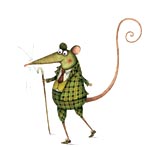Spectator: Dead, dead, dead
Lucy Baring doesn’t have green fingers.

I’ve got poison fingers.’ This comes out as a statement from Miranda as we stand side by side staring at her flower-bed, in which most things look either dead or nearly dead. And, truly, I don’t mean dormant.
We’ve been down this route before: she complains that everything dies, I suggest some plants I believe to be poison-finger proof, she says she’s tried them, I suggest she needs to improve the soil, she says she’s done nothing else all winter but shovel barrows full of manure into the beds. And we go our separate ways.
The following week, I return to see some miniature pink annuals, which look like small, lonely pom-poms. She’s bought these from the garage because she liked the colour and, in some ways, they sum up aspects of her character: she’s not extravagant and can’t bring herself to buy more than one or two plants at a time. She’s extremely impatient and she’s very, very tidy. These three things do not, I suspect, make a flowerbed thrive, but I would not really know as this is definitely the blind leading the blind.
At our last house, I planted pretty much everything in the wrong place, apart from one happy accident involving Veronica gentianoides and alliums, but that sense of failure is easily forgotten when the catalogues come in the post and off you go again, turning down the corners of pages of potential beauty. I never got to grips with the ground elder. I was once told to cover the stuff with lawn mowings that would block the light and thus stifle the weed. In fact, this acted as a delicious mulch in which the elder thrived. This is typical of my approach, however—always seeking the easiest, laziest option.
You can tell a lot about a person from their garden. My brother-in-law, a former soldier, has planted rows of daffodils in straight lines which are now marching blindly (now they’re without flower) down the garden like drilling platoons. He is disturbed that one section has fallen out of line but remedial action is being taken with use of graph paper and photographic records. My sister is used to it. She knew she was marrying someone with a magnificent filing system.
There are plants you can take against (my mother, for instance, has never planted sweet peas, having developed a deep resentment for them as a child when she was told to pick them every evening) and there are plants that take against you: Zam is on his third asparagus bed, which currently looks as barren as its predecessors. It won’t be his last.
Bearing this perseverance in mind, I suggest some of the more thuggish plants to Miranda. What about Alchemilla mollis? ‘Tried that,’ she replies. ‘Dead, dead, dead.’ This really is surprising and I ask her for a list of all the things she’s planted, partly out of curiosity and partly out of research as she lives just a few miles away.
Sign up for the Country Life Newsletter
Exquisite houses, the beauty of Nature, and how to get the most from your life, straight to your inbox.
I receive the following email: ‘Hibiscus, potentilla x3, philadelphus, magnolia trees x2 (quite big), hydrangeas, phlox, witch hazel, Japanese anemones, irises, echinacea, peonies, poppies, del-phiniums/lupins/hollyhocks (slugs) cosmos (slugs within 24 hours), absolutely all veg except a lucky crop of carrots and courgettes (but never from seed, which all die at 2in). I could go on through eight very expensive and heart-breaking years.’
The next day, I take delivery of various plants I’ve ordered and realise there are too many Myrtus communis tarentina, so I decide to give one to Miranda as a late birthday present.
She’s at the kitchen table with the catalogues out, the corners down. ‘I want the pots to look like that,’ she tells me, stabbing a beautiful image of trailing pelargoniums and erigerons in shabby-chic pots. I leave her the myrtle (‘Well, I like the name,’ she says, eyeing the plant with suspicion and perhaps fear) and I drive away knowing that I’ve just sent a plant to certain death.

Town mouse watches a Shakespeare play
Town mouse visits Theatre Royal, Margate.

Country mouse celebrates spring
Country mouse revels in the joys of the new season.
-
 380 acres and 90 bedrooms on the £25m private island being sold by one of Britain's top music producers
380 acres and 90 bedrooms on the £25m private island being sold by one of Britain's top music producersStormzy, Rihanna and the Rolling Stones are just a part of the story at Osea Island, a dot on the map in the seas off Essex.
By Lotte Brundle
-
 'A delicious chance to step back in time and bask in the best of Britain': An insider's guide to The Season
'A delicious chance to step back in time and bask in the best of Britain': An insider's guide to The SeasonHere's how to navigate this summer's top events in style, from those who know best.
By Madeleine Silver